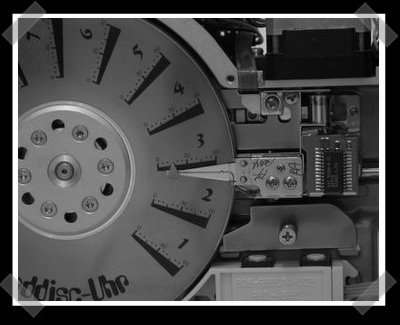
[Fred] sent in this awesome hard drive clock. Nope, just parts of a HD into a clock, but the actual drive mechanism and heads are used for this one. The arms move in and out to indicate minutes and the platter position is used to show the hour. It uses a 50hz clock, logic chips and some scrounged parts to get it all done.
25 thoughts on “Hard Drive Clock (not A Lame Clock With A Hd Face)”
Leave a Reply to digital.wraithCancel reply
Please be kind and respectful to help make the comments section excellent. (Comment Policy)















this hack is chock full of win
Anyone able to get this into english? I’d live to do this hack, but cant understand the language, and translation isnt helping…
That’s the 2nd coolest HDD clock I’ve seen… the first coolest being this one: http://www.youtube.com/watch?v=uJlcRKu2mtQ
BabbleFish is being difficult. Does anyone have a full English translation of the site? Better yet. Anyone have a link for the schematic needed to build this toy?
IMO, this is better.
the only thing that would make this better would be to implement maxtor’s musical drive http://www.youtube.com/watch?v=Bv7PCalQSxI
as an alarm
Nice! I like that lighted clock as well. Does anyone know of a different guide that has steps, instead of just a general ‘this is how it works’ kind of thing? My German is a bit rusty and doesn’t include all the technical language (though it is possible to figure it out).
Also there is a typo in the entry =P
“Nope, just parts of a HD into a clock, but the actual drive mechanism and heads are used for this one.”
Just add a not in front of just.
Google hacking: type: filetype:log “password.log” this code shows passwords
Just to put a timestamp on this: This has been one result of a competition by German tech news magazine “c’t” which has taken place between November 2004 and February 2005.
That one from the same contest is also neat:
http://www.heise.de/ct/machflott/projekte/55876
now _that’s_ a clock you can set your watch to!
I’ll set my watch and warrant on it.
That’s a nice use of a huge old hard drive.
great :) i’ve planned to do something like this for a while
far and away the best hard drive clock i’ve ever seen. nice work
does that arm move laterally? cus ive never seen that before. any drive you open up today the arm moves on an axis in a pie like shape.
it looks like it moves laterally considering he has like a number line on the disc to indicate minuet. Theres probably only a select few number of hard drives out there like this.
My father has been doing things like this to old 8mb hard drives for years now. Nothing new, but it’s good to see old technology being recycled. :)
The only thing cooler would be to spin up the drive to speed and then strobe the disk to indicate the time, with the strobe progressively lagging the flash to advance the markings on the disk.
HI
very nice
alert(document.cookie)
@chupa – you could move both the drive and the arm.. thus allowing it to follow the lines he’s drawn. =)
@monopole – that would be cool.. using a hole in the arm to silhouette the indicated time.. that’d be nice too!
the picture shows the time at about 3:10 with the arm being flush with the line so im making an educated guess that the arm moves laterally. your right you could do it with a pie one but it woldent look as good imo.
I have an old 700Mb drive that has lateral moving heads, my guess is that this hack will only work with those older drives.
A 700 MB drive with such heads? Wow! Even the oldest 5 1/4″ HDD i ever had in my hands had the “modern” type of heads…
@13
judging from the edge connector on the circuit board, it appears to be an old half-height MFM or RLL drive. its built kinda like an old floppy drive, but of course with hard, non-removable platters. the arm is controlled by a stepper motor (the squar-ish black thing in the upper right), which were rather notorious for falling out of alignment in certain circumstances. which lead to the magnet and voice coil in use today.
@20
yes, yes this is known, and covered in an article posted quite some time ago (ie, not this one)
Chupa:
Yes, older hard drives used to be parallel to the walls of the case. You can tell from the circuit board that this hard drive is an MFM type drive… which predates IDE and was quite common in 8086/88 and 286 type boxes. (The standard is about 15-20 years old now) MFM’s pretty much came only in a 5.25″ (size of a CDRom drive) form factor… so I can understand why the guy who made the HD clock used an MFM drive… larger platter size. That hard drive in the hack probably had a maximum capacity of about 10, 20 or 40 Megabytes.
check out http://www.debrace.com/home.php?cat=2. These guys are selling Hard Drive Clocks built from recycled hard drives with nice finishing.